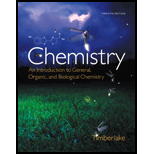
EBK CHEMISTRY
12th Edition
ISBN: 9780133911312
Author: Timberlake
Publisher: YUZU
expand_more
expand_more
format_list_bulleted
Concept explainers
Question
Chapter 18.6, Problem 18.48QAP
Interpretation Introduction
To determine: The H+ proton gradient establishment.
Expert Solution & Answer
Want to see the full answer?
Check out a sample textbook solution
Students have asked these similar questions
None
Review: Design a total
total
synthesis
synthesis
of the following compound using
methyloxacyclopropane and any other necessary reagents.
None
Chapter 18 Solutions
EBK CHEMISTRY
Ch. 18.1 - Prob. 18.1QAPCh. 18.1 - Prob. 18.2QAPCh. 18.1 - Prob. 18.3QAPCh. 18.1 - Prob. 18.4QAPCh. 18.1 - Prob. 18.5QAPCh. 18.1 - Prob. 18.6QAPCh. 18.2 - Prob. 18.7QAPCh. 18.2 - Prob. 18.8QAPCh. 18.2 - Prob. 18.9QAPCh. 18.2 - Prob. 18.10QAP
Ch. 18.2 - Prob. 18.11QAPCh. 18.2 - Prob. 18.12QAPCh. 18.3 - Prob. 18.13QAPCh. 18.3 - Prob. 18.14QAPCh. 18.3 - Prob. 18.15QAPCh. 18.3 - Prob. 18.16QAPCh. 18.4 - Prob. 18.17QAPCh. 18.4 - Prob. 18.18QAPCh. 18.4 - Prob. 18.19QAPCh. 18.4 - Prob. 18.20QAPCh. 18.4 - Prob. 18.21QAPCh. 18.4 - Prob. 18.22QAPCh. 18.4 - Prob. 18.23QAPCh. 18.4 - Prob. 18.24QAPCh. 18.4 - Prob. 18.25QAPCh. 18.4 - Prob. 18.26QAPCh. 18.4 - Prob. 18.27QAPCh. 18.4 - Prob. 18.28QAPCh. 18.4 - Prob. 18.29QAPCh. 18.4 - Prob. 18.30QAPCh. 18.5 - Prob. 18.31QAPCh. 18.5 - Prob. 18.32QAPCh. 18.5 - Prob. 18.33QAPCh. 18.5 - Prob. 18.34QAPCh. 18.5 - Prob. 18.35QAPCh. 18.5 - Prob. 18.36QAPCh. 18.5 - Prob. 18.37QAPCh. 18.5 - Prob. 18.38QAPCh. 18.5 - Prob. 18.39QAPCh. 18.5 - Prob. 18.40QAPCh. 18.6 - Prob. 18.41QAPCh. 18.6 - Prob. 18.42QAPCh. 18.6 - Prob. 18.43QAPCh. 18.6 - Prob. 18.44QAPCh. 18.6 - Prob. 18.45QAPCh. 18.6 - Prob. 18.46QAPCh. 18.6 - Prob. 18.47QAPCh. 18.6 - Prob. 18.48QAPCh. 18.6 - Prob. 18.49QAPCh. 18.6 - Prob. 18.50QAPCh. 18.6 - Prob. 18.51QAPCh. 18.6 - Prob. 18.52QAPCh. 18.6 - Prob. 18.53QAPCh. 18.6 - Prob. 18.54QAPCh. 18.7 - Prob. 18.55QAPCh. 18.7 - Prob. 18.56QAPCh. 18.7 - Prob. 18.57QAPCh. 18.7 - Prob. 18.58QAPCh. 18.7 - Prob. 18.59QAPCh. 18.7 - Prob. 18.60QAPCh. 18.7 - Prob. 18.61QAPCh. 18.7 - Prob. 18.62QAPCh. 18.7 - Prob. 18.63QAPCh. 18.7 - Prob. 18.64QAPCh. 18.8 - 18.65 Draw the condensed structural formula for...Ch. 18.8 - 18.66 Draw the condensed structural formula for...Ch. 18.8 - 18.67 Why does the body convert NH4+ to urea?
Ch. 18.8 - Prob. 18.68QAPCh. 18.8 - Prob. 18.69QAPCh. 18.8 - Prob. 18.70QAPCh. 18 - Prob. 18.71UTCCh. 18 - Prob. 18.72UTCCh. 18 - Prob. 18.73UTCCh. 18 - Prob. 18.74UTCCh. 18 - Prob. 18.75AQAPCh. 18 - Prob. 18.76AQAPCh. 18 - Prob. 18.77AQAPCh. 18 - Prob. 18.78AQAPCh. 18 - Prob. 18.79AQAPCh. 18 - Prob. 18.80AQAPCh. 18 - Prob. 18.81AQAPCh. 18 - Prob. 18.82AQAPCh. 18 - Prob. 18.83AQAPCh. 18 - Prob. 18.84AQAPCh. 18 - Prob. 18.85AQAPCh. 18 - Prob. 18.86AQAPCh. 18 - Prob. 18.87AQAPCh. 18 - Prob. 18.88AQAPCh. 18 - Prob. 18.89AQAPCh. 18 - Prob. 18.90AQAPCh. 18 - Prob. 18.91CQCh. 18 - Prob. 18.92CQCh. 18 - Prob. 18.93CQCh. 18 - Prob. 18.94CQCh. 18 - Prob. 18.95CQCh. 18 - Prob. 18.96CQCh. 18 - Prob. 33CICh. 18 - Prob. 34CICh. 18 - Prob. 35CICh. 18 - Prob. 36CICh. 18 - Prob. 37CICh. 18 - Prob. 38CICh. 18 - Prob. 39CICh. 18 - Thalassemia is an inherited genetic mutation that...Ch. 18 - CI.34 In response to signals from the nervous...
Knowledge Booster
Learn more about
Need a deep-dive on the concept behind this application? Look no further. Learn more about this topic, chemistry and related others by exploring similar questions and additional content below.Similar questions
- Draw a Newman projection from carbon 3 to carbon 2 in the highest energy conformation for the following molecule. What is this conformation called? What kind of strain is present? Brarrow_forwardWhich of the following dienophiles is most reactive in a Diels-Alder reaction: Please explain why the correct answer to this question is option 5. Please provide a detailed explanation.arrow_forwardWhich of the following would you expect to be aromatic? Please provide a detailed explanation.arrow_forward
- Draw the enantiomer and diastereomers of the following molecule. Label each type of stereoisomers. Label each chiral center as R or S. HOarrow_forwardWhich diene and dienophile would you choose to synthesize the following compound? Please provide a detailed explanation. Please include a drawing showing the mechanism of the synthesis. Please also explain why it is the correct diene and dienophile.arrow_forwardUsing the sketcher below, draw the structure of N-ethyldecylamine. Answer: 0 ୨୫) . 始 {n [ ]t ?arrow_forward
- Which of the following would you expect to be aromatic? Please provide a detailed explanation.arrow_forwardIdentify the characteristic signals that you would expect in the diagnostic region of an IR spectrum of each of the following compounds. a. H₂N b.arrow_forwardWhat is the lowest energy chair for the following cyclohexane? ' || || a. b. " " d.arrow_forward
arrow_back_ios
SEE MORE QUESTIONS
arrow_forward_ios
Recommended textbooks for you
 ChemistryChemistryISBN:9781305957404Author:Steven S. Zumdahl, Susan A. Zumdahl, Donald J. DeCostePublisher:Cengage Learning
ChemistryChemistryISBN:9781305957404Author:Steven S. Zumdahl, Susan A. Zumdahl, Donald J. DeCostePublisher:Cengage Learning ChemistryChemistryISBN:9781259911156Author:Raymond Chang Dr., Jason Overby ProfessorPublisher:McGraw-Hill Education
ChemistryChemistryISBN:9781259911156Author:Raymond Chang Dr., Jason Overby ProfessorPublisher:McGraw-Hill Education Principles of Instrumental AnalysisChemistryISBN:9781305577213Author:Douglas A. Skoog, F. James Holler, Stanley R. CrouchPublisher:Cengage Learning
Principles of Instrumental AnalysisChemistryISBN:9781305577213Author:Douglas A. Skoog, F. James Holler, Stanley R. CrouchPublisher:Cengage Learning Organic ChemistryChemistryISBN:9780078021558Author:Janice Gorzynski Smith Dr.Publisher:McGraw-Hill Education
Organic ChemistryChemistryISBN:9780078021558Author:Janice Gorzynski Smith Dr.Publisher:McGraw-Hill Education Chemistry: Principles and ReactionsChemistryISBN:9781305079373Author:William L. Masterton, Cecile N. HurleyPublisher:Cengage Learning
Chemistry: Principles and ReactionsChemistryISBN:9781305079373Author:William L. Masterton, Cecile N. HurleyPublisher:Cengage Learning Elementary Principles of Chemical Processes, Bind...ChemistryISBN:9781118431221Author:Richard M. Felder, Ronald W. Rousseau, Lisa G. BullardPublisher:WILEY
Elementary Principles of Chemical Processes, Bind...ChemistryISBN:9781118431221Author:Richard M. Felder, Ronald W. Rousseau, Lisa G. BullardPublisher:WILEY

Chemistry
Chemistry
ISBN:9781305957404
Author:Steven S. Zumdahl, Susan A. Zumdahl, Donald J. DeCoste
Publisher:Cengage Learning

Chemistry
Chemistry
ISBN:9781259911156
Author:Raymond Chang Dr., Jason Overby Professor
Publisher:McGraw-Hill Education

Principles of Instrumental Analysis
Chemistry
ISBN:9781305577213
Author:Douglas A. Skoog, F. James Holler, Stanley R. Crouch
Publisher:Cengage Learning

Organic Chemistry
Chemistry
ISBN:9780078021558
Author:Janice Gorzynski Smith Dr.
Publisher:McGraw-Hill Education

Chemistry: Principles and Reactions
Chemistry
ISBN:9781305079373
Author:William L. Masterton, Cecile N. Hurley
Publisher:Cengage Learning

Elementary Principles of Chemical Processes, Bind...
Chemistry
ISBN:9781118431221
Author:Richard M. Felder, Ronald W. Rousseau, Lisa G. Bullard
Publisher:WILEY
Molecular spectroscopy; Author: Vidya-mitra;https://www.youtube.com/watch?v=G6HjLIWvCQo;License: Standard YouTube License, CC-BY